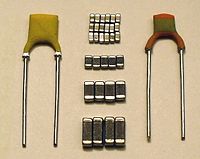
Photo from wikipedia
Abstract This paper describes an investigation of the interface of a multilayer device consisting of a Pb-free ferroelectric material (Bi0.37Na0.37Sr0.26)TiO3 (BNST) and a base metal (Cu)-noble metal (Ag) mixture that… Click to show full abstract
Abstract This paper describes an investigation of the interface of a multilayer device consisting of a Pb-free ferroelectric material (Bi0.37Na0.37Sr0.26)TiO3 (BNST) and a base metal (Cu)-noble metal (Ag) mixture that were co-fired in air and a reducing atmosphere. The stability of the interface between CuAg inner electrode layer and the BNST ceramic layer was evaluated with regard to the Gibbs free energy using the Ellingham diagram and interdiffusion of the metallic electrode elements. The CuO and Ag were utilized as raw materials for the internal electrode of multilayer ceramic devices. These devices were burned out and sintered in air, and an additional heat treatment was performed at 300 °C in N2 (95 vol%)/H2 (5 vol%) mixed gas to convert CuO into Cu. In the process of co-firing, the diffusion of Cu from the CuAg electrode layer caused the BNST ceramic layer to transform from a ferroelectric phase into a relaxor phase. This was confirmed via scanning electron microscopy and transmission electron microscopy, and by measuring the temperature dependence of the strain and polarization behaviors of CuAg/BNST devices with different ceramic-layer thicknesses (18–126 μm). The thin-layer (18 μm) sample exhibited electromechanical properties representing a strong relaxor phase, whereas properties corresponding to a mixed ferroelectric/relaxor phase were observed in the thick-layer (126 μm) sample. Additionally, the point of transition from the ferroelectric to relaxor phase (Tr-f) of the sample device with a ceramic-layer thickness of 126 μm was higher than that of the sample with a ceramic-layer thickness of 18 μm. This difference was due to the reduction in the stability of the ferroelectric phase, which was caused by the diffusion of Cu into the ceramic layer of the multilayer device.
Journal Title: Journal of Alloys and Compounds
Year Published: 2020
Link to full text (if available)
Share on Social Media: Sign Up to like & get
recommendations!